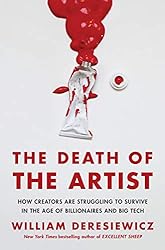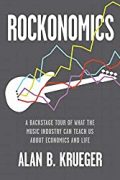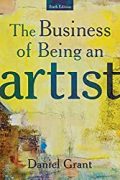
Rating: 7.8/10.
The Death of the Artist: How Creators Are Struggling to Survive in the Age of Billionaires and Big Tech by William Deresiewicz
Book about the economic challenges faced by artists of various types, including musicians, visual artists, writers, etc. Despite often being highly educated, artists are consistently among the lowest earners in the US. Many earn less than 20k a year, falling behind professions that pay minimum wage; it’s common for artists, regardless of their medium, to struggle financially, living with parents or roommates well into their 30s and 40s.
Culturally, there’s a bit of a taboo around artists discussing money. Many artists feel their work transcends finances, or that art shouldn’t be about money. However, in reality, artists need to eat, and creating art can be expensive: even a low-budget film might cost tens of thousands. Living in poverty is also not conducive to producing art, and enduring such a life can be draining. Some argue that artists should create for the love of it and not for money, but this argument doesn’t hold up: producing art requires skill, and the quality difference between amateur and professional work is significant. If there’s no financial incentive for art, we all lose out as less will be produced. Moreover, professional artists arguably have a deeper passion for their craft than anyone else.
It’s healthier for artists to treat their craft as a business: invest upfront and aim to generate enough revenue to offset those costs. Any profit can then fund new creations. Today, artists not only create but also handle the business side of things, like marketing and sourcing multiple income streams. This multitasking approach is relatively new, decades ago, there were more regular employment careers in the arts, with others doing marketing, but now, most artists are self-employed. An artist’s life is constantly on the financial edge, always battling doubt. As years pass, they often question whether to keep fighting for their passion or switch to a more lucrative plan B.
Society often pins the blame on artists for their financial struggles. Many in tech argue that success is attainable for those who try hard enough, and many types of art can be produced cheaply using free software and free distribution via the internet. However, the issue is there’s an almost infinite supply of artists doing the same thing, so to stand out, you need an edge, like being an early adopter of a platform or leveraging an existing brand. The art economy is skewed, with a small percentage of big names earning the lion’s share. Worse, the overall earnings pot is shrinking, as piracy is rampant and many consumers expect to access art for free.
Artists have a unique relationship with the cities they reside in. Rents are high in major centers like New York and LA; however, many aspiring artists feel the need to stay there to boost their chances because of networking benefits. Being in the right place to connect with the right people and attend key events is crucial, so relocating to a cheaper place is usually not an option. Ironically, artists can be the cause of their own downfall; by creating art, they can make a neighborhood more desirable, leading to rising costs. Since artists are among the poorest demographics in the country, so as rents climb, the very artists enhancing a neighborhood’s appeal quickly get forced out. Any remaining art, post-gentrification, often becomes heavily commercialized to maximize profit.
The next section of the book discusses various artist types, starting with musicians. Since the early 2000s, the rise of the internet has decimated the music industry. In the modern era, musicians often struggle to earn from their music alone, as revenue from streaming is much lower than what was earned from selling CDs. Now, the main income for many musicians comes from touring; but touring has downsides, as time spent on the road means less time producing new music.
Writers – Most books experience disappointing sales if they even get published at all. The market is oversaturated, and it’s challenging for authors, especially fiction writers, to stand out. Self-publishing has become a popular route for those who can’t secure a traditional publisher, but self-publishing results in books being sold at much lower prices, negatively impacting the industry, and threatening to set an expectation among readers to get novels almost for free. The industry must avoid going down the same path as the music industry, where most content is now virtually free. Often, writers have to take on projects they’re not passionate about, like writing marketing copy, just to make ends meet.
Visual art – this area might seem lucrative, with some artwork fetching millions at auctions, but this isn’t the reality for the majority. Most artists struggle, and the pricing in the art world can seem arbitrary, even to the artists themselves. The book provides examples of successful artists; a common thread among them is that they focus on producing what the audience wants, not necessarily what they’re personally inclined to create.
Film and TV present a different story. While the film industry has faced challenges recently, TV is thriving, thanks in part to investments from streaming platforms like Netflix. Making films requires significant funds; even a low-budget indie movie can cost several hundred thousand dollars. Aspiring filmmakers aim to have their work showcased at major film festivals, like Sundance, hoping to gain attention from big industry names and kickstart their careers.
The next section discusses the history of art across various paradigms and periods. In the earliest period, art was closely tied to religion. The Renaissance marked a shift where artists began expressing themselves and introducing new ideas outside of religious contexts. By the early 20th century, art began to become institutionalized with the emergence of art schools and individuals pursuing art as a profession. However, many artists tend to distance themselves from appearing professional, seeing themselves more as individuals focused on self-expression rather than market-driven.
Now, we’re entering a period where artists are increasingly influenced by market forces. They often have to think more about business and entrepreneurship rather than just pure creativity. Artists need to consider their audience and what unique value they bring. While the internet offers opportunities to build a specific fan base, artists have to cater to their audience’s preferences, even if it might not align with their personal artistic vision. Success now hinges on metrics, like audience appreciation, forcing artists to cater to these metrics.
There are mixed opinions on whether art schools are worth it. Objectively, they have extremely poor ROI financially, and often fail to prepare artists for the realities of today’s market, where an entrepreneurial mindset is crucial. Many professors might be out of touch with the current industry or entered it when the landscape was different. Art schools should address these gaps in their curriculum rather than leaving students unprepared after graduation.
Artists are struggling due to piracy. The rampant piracy of their content on the internet makes it hopeless, to file DMCA requests; the issue is exacerbated by sites that base their business models on piracy. While some argue that piracy is a victimless crime, it has widespread consequences. Piracy renders it financially unfeasible to produce art, leading to a decrease in the creation of new content. The solution is to change the norms to normalize paying for content, and stop normalizing the idea that artists create art purely for passion without financial incentives.
This book reinforces many points I’ve encountered in other books on economics of art, such as “Rockonomics” (focused on the music industry) and “Merchants of Culture” (centered on the publishing industry). A recurring theme in these sources is the financial struggle most artists face, living near poverty levels. Additionally, there’s massive inequality in the distribution of the limited revenue within these industries. The author suggests that one significant reason for these struggles is that artists tend to resist adopting a business mindset. As a result, they often produce works that might appeal to themselves but fail to differentiate them from others in the market, making it hard to attract a broader audience.
However, the author selects examples to fit the narrative of the struggling artist, while overlooking others that are not struggling as much. For instance, the profitable video game industry isn’t mentioned, and TV shows, which are also lucrative, are only touched on briefly. In music, the focus is predominantly on musicians, with no discussion on areas like the retail and manufacturing of musical instruments, which tend to be more profitable.



